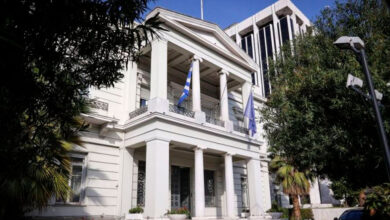
The Washington Post’s art critic Phillip Kennicott, who broke the Armenian Orphan Rug story, has published an article on a major Yousuf Karsh exhibit at the Smithsonian’s National Portrait Gallery.
Karsh witnessed the horrors of the Armenian Genocide before fleeing his homeland, ultimately making his way to Canada, where he lived most of his life.
The article reads as follows:
“Only a few of the Yousuf Karsh photographs on display at the National Portrait Gallery show their subjects out of doors or in natural lighting. Franklin Roosevelt is seen standing beneath a moody sky with three other men in a 1936 shot taken in Canada, and Georgia O’Keeffe sits next to a sliver of light coming from an open window in a 1956 image made in New Mexico. But almost everyone else is indoors, and often in rich and luxurious settings, with the background dark, deep and lustrous, as if painted in oil.
The first of two exhibitions of Karsh’s work at the gallery documents a gift of 109 prints given to the museum by the Armenian-born photographer’s widow, Estrellita Karsh. (Another selection of 27 images will be installed May 2.) The show includes Karsh’s 1941 portrait of Winston Churchill, made immediately after the British prime minister delivered a speech to the Canadian parliament. It is a legendary photograph, as famous for its pure visual power as its historic impact. Churchill is seen in a classic bulldog pose: one hand on his hip, the other holding on to a chair, with a wood-paneled wall behind him.
Karsh had only a few minutes to compose the image, and Churchill wasn’t thrilled to give even that time to the then relatively little-known photographer. The prime minister was also smoking a cigar, which Karsh believed would have marred the final image. As recounted by Karsh, the photographer plucked the cigar from Churchill’s mouth and made his photograph, capturing a scowling, deeply irritated man. That pique read as defiance, and the image (which appeared on the cover of Life magazine and will be seen on a new British five-pound note in 2016) helped define Churchill’s reputation as a pugnacious and heroic last bulwark against Hitler.
It was also an uncharacteristic bit of confrontation on Karsh’s part. Among the famous and fashionable portrait photographers of the past century, Karsh was renowned for being a sympathetic artist, a master of getting the best out of his subjects.
“Karsh is never going to try to get you at an awkward moment,” says Ann Shumard, senior curator of photographs at the NPG. “He’s not a gritty photographer.”
Compare that with an anecdote about Richard Avedon, in an essay by David Travis that introduces the book “Yousuf Karsh: Regarding Heroes.” Both Karsh and Avedon photographed the duke and duchess of Windsor (formerly King Edward VIII of England and Wallis Simpson), with strikingly different results. Karsh’s image shows two distinguished and immaculately dressed people, looking into each other’s eyes with affection. Avedon shows the same couple, staring directly into the camera, seemingly stricken, with the duchess’s face a mask of grotesque theatrical anguish. Avedon claims to have told the bluebloods a made-up a story about a dog run over by a car, causing the animal lovers to assume horrified expressions just as he clicked his camera. It was a trick, to elicit something beyond the carefully rehearsed public face of the two royals.”








